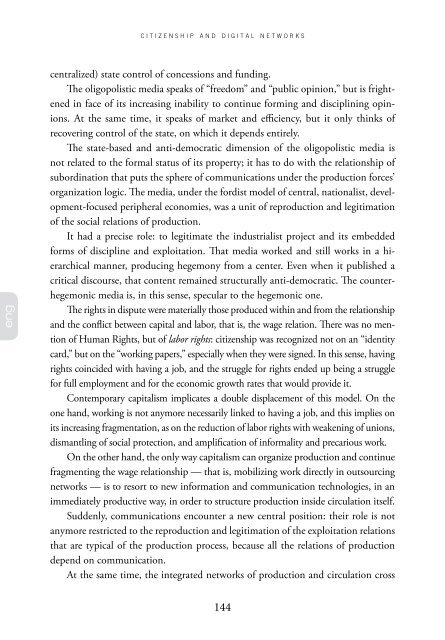Sergio Amadeu da Silveira - Cidadania e Redes Digitais
Sergio Amadeu da Silveira - Cidadania e Redes Digitais
Sergio Amadeu da Silveira - Cidadania e Redes Digitais
You also want an ePaper? Increase the reach of your titles
YUMPU automatically turns print PDFs into web optimized ePapers that Google loves.
eng<br />
c i t i z e n s h i p a n d d i g i t a l n e t w o r k s<br />
centralized) state control of concessions and funding.<br />
The oligopolistic media speaks of “freedom” and “public opinion,” but is frightened<br />
in face of its increasing inability to continue forming and disciplining opinions.<br />
At the same time, it speaks of market and efficiency, but it only thinks of<br />
recovering control of the state, on which it depends entirely.<br />
The state-based and anti-democratic dimension of the oligopolistic media is<br />
not related to the formal status of its property; it has to do with the relationship of<br />
subordination that puts the sphere of communications under the production forces’<br />
organization logic. The media, under the fordist model of central, nationalist, development-focused<br />
peripheral economies, was a unit of reproduction and legitimation<br />
of the social relations of production.<br />
It had a precise role: to legitimate the industrialist project and its embedded<br />
forms of discipline and exploitation. That media worked and still works in a hierarchical<br />
manner, producing hegemony from a center. Even when it published a<br />
critical discourse, that content remained structurally anti-democratic. The counterhegemonic<br />
media is, in this sense, specular to the hegemonic one.<br />
The rights in dispute were materially those produced within and from the relationship<br />
and the conflict between capital and labor, that is, the wage relation. There was no mention<br />
of Human Rights, but of labor rights: citizenship was recognized not on an “identity<br />
card,” but on the “working papers,” especially when they were signed. In this sense, having<br />
rights coincided with having a job, and the struggle for rights ended up being a struggle<br />
for full employment and for the economic growth rates that would provide it.<br />
Contemporary capitalism implicates a double displacement of this model. On the<br />
one hand, working is not anymore necessarily linked to having a job, and this implies on<br />
its increasing fragmentation, as on the reduction of labor rights with weakening of unions,<br />
dismantling of social protection, and amplification of informality and precarious work.<br />
On the other hand, the only way capitalism can organize production and continue<br />
fragmenting the wage relationship — that is, mobilizing work directly in outsourcing<br />
networks — is to resort to new information and communication technologies, in an<br />
immediately productive way, in order to structure production inside circulation itself.<br />
Suddenly, communications encounter a new central position: their role is not<br />
anymore restricted to the reproduction and legitimation of the exploitation relations<br />
that are typical of the production process, because all the relations of production<br />
depend on communication.<br />
At the same time, the integrated networks of production and circulation cross<br />
144


